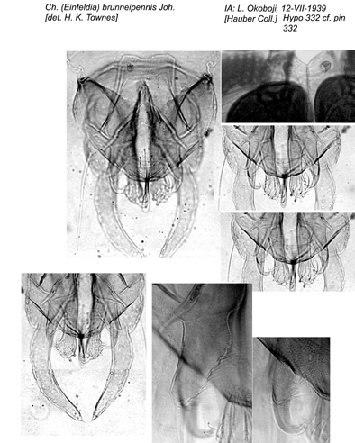The immatures of this species are previously undescribed.
MaleAdult description from Townes (1945) and Sæther (2012)
Male:
The adult male is characterized by its brown thorax, abdomen and haltere knob; large frontal tubercles; strongly spatulate anal point and pediform basal part of superior volsella.
Wing length 2.84-3.10 mm. AR 2.81-2.86. LR 1.70-1.86. Fore tarsus without a beard, BR 2.4-2.7.
Adult male characters of B. brunneipennis
Male terminalia of B. brunneipennis (left), with frontal tubercles (upper right)
and superior volsella, inferior volsella and anal point.
(Photo courtesy of the late J.E. Sublette.)
Frontal tubercles 41-50 µm high, 22-23 µm wide. Clypeus with 19-22 setae. Palpal proportions (micron): 50-64, 58-68, 168-183, 185-196, 283-303.
Thorax: Antepronotum bare. Dorsocentrals 13-18, acrostichals absent, prealars 4-5, supraalar 1. Scutellum with 15-21 setae.
Lengths and proportions of legs (micron)
| | Fe | Ti | Ta1 | Ta2 | Ta3 |
| PI | 1613 | 890 | 1644 | 724 | 600 |
| PII | 1157 | 1055 | 625 | 322 | 233 |
| PIII | 1245 | 1316 | 963 | 473 | 365 |
| | Ta4 | Ta5 | LR | F/T | Ta5/Ti |
| PI | 485 | 184 | 1.83-1.90 | 1.79-1.86 | 0.21 |
| PII | 132 | 92 | 0.57-0.60 | 1.09-1.10 | |
| PIII | 184 | 120 | 0.71-0.73 | 0.94-0.95 | |
Tergite IX with 30-36 setae. Base of SVo pediform.Pupa with frontal warts, lacking comb on abdominal segment VIII.
Larva not a typical Chironomus type; small, with only one pair of ventral tubules. Gular region dark and dark spots (Fig. c) at the base of the antenna (Fig. f). Frontoclypeus (Fig. c) without a depression. Dorsal sclerite S1 (Fig. c) with slight rugosity anteriorly.
Mentum (Fig. b) also not like Chironomus; centre tooth narrow with only slight notches near the apex (Type IB), which are readily lost due to wear; 4th laterals quite reduced (Type III).
Ventromentum (Fig. e) similar to that of Chironomus with about 38 striae; separated by about one quarter of width of mentum.
Pecten epipharyngis (Fig. a) partially tripartite, with about 30 fine teeth.
Mandible (Fig. d) with 3 internal teeth (type II), and with striations near base.
Antenna (Fig. f) relatively short, AR about 1.3; basal segment about 3 times as long as wide, ring organ about 0.3 up from base of segment; A2/A1 about 0.19; A4/A3 about 1.63.
Cytology: 3 polytene chromosomes with no obvious sign of Keyl pattern.
Fused chromosome 4 visible as narrow section following a Balbiani ring, on longest chromosome; 2 nucleoli also present, one of which is on the longest chromosome. A third small nucleolus may sometimes be developed on the longest chromosome.
Some inversion polymorphism present.
Found: Manitoba - Lake Winnipeg (Sæther 2012)
Ontario - Mooney's Bay (45.35°N; 75.68°W), Ottawa, Carleton Co.
Arkansas - Galloway, Pulaski Co. (Townes 1945).
Florida - Orlando; West Palm Beach (Townes 1945).
Iowa - Davenport (Townes 1945).
Massachusetts - Amherst (Townes 1945).
Michigan - Manistee Co.; Midland Co. (Townes 1945).
Minnesota - Cass Lake; New Brighton; Nisswa (Townes 1945).
New Jersey - Moorestown (Townes 1945).
New York - Bemus Point, Buffalo; Ithaca; Mayford; Milford Center; Peekskill (Townes 1945).
North Carolina - Raleigh (Townes 1945).
South Dakota -
This species has been placed in Einfeldia, but the characters of the larva indicate that it does not belong to Einfeldia (s.s.). They suggest it belongs to Group B or D of Pinder & Reiss (1983), which probably should be combined. The name Benthalia Lipina, 1939 is available for this combined grouping (Spies, personal communication). However, Spies also points out that Townes (1945) description of the adult describes characters, such as large frontal tubercles and base of superior volsella of male not expanded, that do not fit the diagnosis of Einfeldia (s.l.). The unexpanded base of the superior appendage is, however, not consistent with specimens identified as this species by Townes himself. The species is very similar to the Japanese specimens described as B. dissidens (Walker). The larva of B. natchitocheae (Sublette), is very similar.
The presence of furrows on the mandible suggests that this group might belong in an expanded Chironomus.
The adult of this species was briefly redescribed by Sæther (2012).
See also E. pagana. | Return to Index| Go to References ]